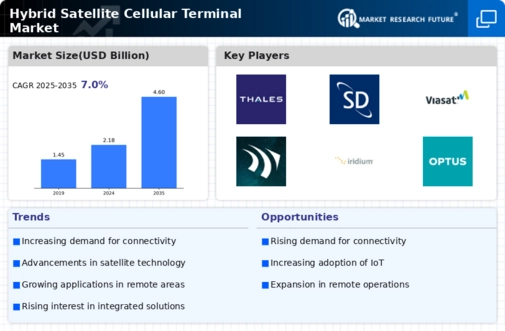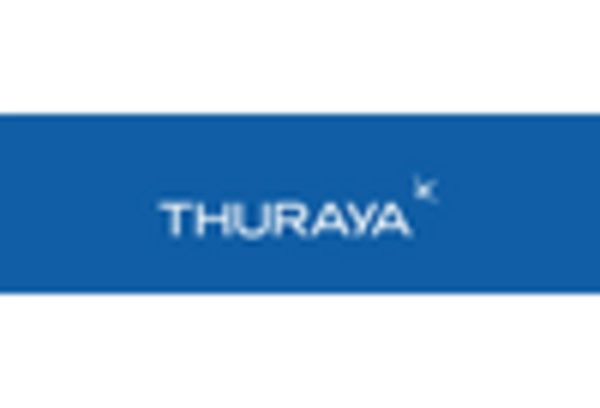Advancements in Satellite Technology
Technological advancements in satellite systems are significantly influencing the Hybrid Satellite Cellular Terminal Market. Innovations such as low Earth orbit (LEO) satellites are enhancing the capabilities of hybrid terminals, allowing for lower latency and improved data transmission speeds. These advancements enable users to experience seamless connectivity, which is crucial for applications in sectors like maritime, aviation, and emergency services. The integration of advanced satellite technology is expected to drive market growth, with estimates suggesting that the adoption of LEO satellites could increase the efficiency of hybrid terminals by up to 30%, thereby expanding their appeal across various industries.
Rising Demand for Mobile Connectivity
The increasing demand for mobile connectivity is a significant factor propelling the Hybrid Satellite Cellular Terminal Market. As mobile devices become ubiquitous, the need for reliable and high-speed internet access in remote locations is paramount. Hybrid terminals offer a solution by providing seamless connectivity that combines the strengths of both satellite and cellular networks. This demand is particularly pronounced in sectors such as oil and gas, mining, and disaster recovery, where traditional cellular networks may be insufficient. Market forecasts indicate that the mobile connectivity segment could account for over 40% of the hybrid terminal market by 2026, reflecting the growing reliance on mobile solutions in various industries.
Emerging Applications in Various Sectors
The emergence of new applications across various sectors is driving growth in the Hybrid Satellite Cellular Terminal Market. Industries such as agriculture, transportation, and logistics are increasingly adopting hybrid terminals to enhance operational efficiency and ensure real-time data transmission. For instance, in agriculture, hybrid terminals facilitate precision farming by enabling farmers to monitor crop conditions remotely. Similarly, in logistics, these terminals support tracking and fleet management in areas with limited cellular coverage. Analysts predict that the diversification of applications could lead to a 20% increase in market penetration for hybrid terminals, highlighting their versatility and adaptability in meeting diverse communication needs.
Growing Demand for Reliable Communication
The Hybrid Satellite Cellular Terminal Market is experiencing a surge in demand for reliable communication solutions, particularly in remote and underserved areas. As businesses and governments seek to maintain connectivity in challenging environments, the need for hybrid terminals that combine satellite and cellular technologies becomes increasingly apparent. This demand is driven by the necessity for uninterrupted communication during emergencies, natural disasters, and in regions lacking robust infrastructure. According to recent data, the market for hybrid terminals is projected to grow at a compound annual growth rate of approximately 12% over the next five years, indicating a strong trend towards integrated communication solutions that ensure reliability and resilience.
Increased Investment in Telecommunications Infrastructure
Investment in telecommunications infrastructure is a key driver for the Hybrid Satellite Cellular Terminal Market. Governments and private entities are recognizing the importance of robust communication networks, particularly in rural and remote areas. This investment is often aimed at enhancing connectivity and ensuring that all regions have access to reliable communication services. As a result, hybrid terminals are being deployed to bridge the connectivity gap, with market analysts projecting that infrastructure investments could lead to a 15% increase in the adoption of hybrid satellite cellular solutions over the next few years. This trend underscores the critical role of hybrid terminals in modern communication strategies.

















Leave a Comment